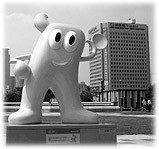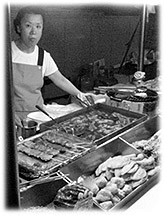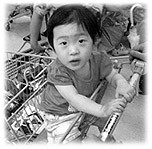
The subway in Seoul is clean, modern and safe. Sometimes you feel like being in a science fiction movie! Every single train station is large-scaled and spaciously built. Fortunately all signboards are bilingual, korean and english. That's why it's easy for english speaking holiday tourists and business travelers to navigate around the Seoul subway system.
Die U-Bahn in Seoul ist sehr sauber, modern und sicher. Man fühlt sich teilweise wie in einem Science-Fiction-Film! Jede einzelne U-Bahn-Station ist großzügig und weitläufig gebaut. Glücklichwerweise sind alle Schilder zweisprachig, also koreanisch und englisch. Als englisch sprechender Tourist oder als Geschäftsreisender in Südkorea findet man sich daher dort gut zurecht.
First you have to buy a T-money-card at a ticket machine. The card costs 1000 won (0.85 US dollar). After purchasing the card, you have to load it up with some money at the same machine. With the T-money-card you can pay the subway rides, each is between 900 (0.75 US dollar) and 1500 won (1.25 US dollar). Also you can pay bus and taxi by the T-money-card, sometimes even at convenience stores or other shops. As you can see on the photo above, you can choose the english language for using the ticket machine. Most devices in South Korea are bilingual, Korean and English. See the video below to get more information about the T-money card and the Seoul subway system.
Zunächst muss man sich an einem der U-Bahn-Automaten eine "T-Money-Card" besorgen, welche 1000 Won (0,65 EUR) kostet. Anschließend lädt man diese mit einem bestimmten Geldbetrag am gleichen Automaten auf, um die einzelnen U-Bahn-Fahrten zu bezahlen, welche 900 Won (0,65 EUR) bis 1500 Won (1,00 EUR) kosten. Mit der T-Money-Card kann man darüber hinaus noch den Bus, das Taxi, und sogar in manchen Geschäften in Seoul bezahlen. Wie man auf dem oberen Bild gut erkennen kann, ist der Touchscreen des T-Money-Automaten auch auf Englisch zu bedienen. Die meisten Automaten in Südkorea sind auf koreanisch und auf englisch benutzbar. In dem Video am Ende dieser Seite gibt es weitere Informationen über die T-Money-Card und das Seoul U-Bahn-System
After purchasing and loading the T-money-card, you have to make a plan for your subway journey. To do this you can find huge touchscreens at each Seoul subway station, which show the full subway system net. Of course you can choose the english language here as well. You touch with your finger on the starting and ending point, and the computer calculates the best route through the subway system for you. Please see the Seoul subway video for additional information. The Koreans love those touchscreens and use them many times to get their subway route calculated.
Nachdem die T-Money-Card gekauft und aufgeladen wurde, muss die Reise geplant werden. Hierzu finden sich in allen Seoul U-Bahn-Stationen große Touchscreens, die das U-Bahn-Netz darstellen. Auch diese können in Englisch bedient werden. Man tippt mit dem Finger auf den Start- und anschließend auf den Zielpunkt und erhält automatisch einen Routenvorschlag durch das U-Bahn-Netz vom Computer. Die Koreaner lieben diese Touchscreens und benutzen sie häufig. Dadurch, dass der Bildschirm so groß ist erhält man eine sehr gute Übersicht über das Netz. Das Seoul U-Bahn-Video auf dieser Seiten zeigt den Touchscreen in Aktion!

All directions are bilingual tagged, Korean and English. The colors and the numbers show the different subway train lines. For example, the green color on the picture above shows subway line number 2. This is the useful circle line which circles the Seoul city center.
Alle Wege sind gut und zweisprachig beschildert. Die Farben und Nummern symbolisieren die einzelnen U-Bahn-Linien. Die grüne Farbe oben auf dem Bild zeigt beispielsweise die U-Bahn-Linie Nummer 2, welches die sehr praktische Ringbahnlinie ist und einmal um das Stadtzentrum von Seoul herumführt.
Before you can enter the subway, you have to put your T-money-card onto the entrance controlling machine. This machine that you can see on the photo above is checking if you have enough money loaded on your card. If yes, the machine opens the doors automatically and charges the T-money-card with the amount of the fare. At first there will be 900 won (0.75 US dollar) charged. At the end of your ride you have to put the card onto the exit machine to get out. The exit machine checks how long your ride was and charges the additional money.
Bevor man in die U-Bahn einsteigen kann, muss man seine T-Money-Card auf die Einlassmaschine legen. Diese Maschine, die man oben auf dem Foto sieht, prüft, ob genug Geld auf der Karte ist. Wenn ja, dann öffnet sie die Türen und bucht den Fahrpreis automatisch von der Karte ab. Zunächst werden immer 900 Won (0,65 EUR) abgebucht. Am Ende der Fahrt muss man die T-Money-Card wieder auf den Automaten am Ausgang legen, es wird überprüft wie weit man gefahren ist, und der entsprechende Mehrbetrag wird abgebucht.
All subway stations are huge! On the photo above you see only half of the station. All of the stations are very clean, tidy and clearly arranged. Unfortunately they are almost all times quite crowded, the picture above is an exception because it was taken on a sunday evening. The yellow lines on the floor are made for blind people to get some orientation inside the station. The glas wall on the left side is made to prevent people from doing suicide by jumping onto the tracks. The subway stops directly behind the glass doors, so that the passengers always know where exactly the train stops and where to wait for the doors to enter. Please watch the video on this page to see the sliding doors in action.
Alle U-Bahn-Stationen sind riesig. Auf dem oberen Bild sieht man nur die Hälfte der Bahnsteiglänge. Sie sind sehr sauber und übersichtlich. Leider meist völlig überfüllt, das obere Bild ist die Ausnahme und wurde an einem Sonntagabend aufgenommen. Die gelben Streifen auf dem Boden dienen den Blinden zur Orientierung. Die Glaswand links im Bild wurde eingeführt, damit sich keine Selbstmörder mehr auf die Gleise stürzen können. Die U-Bahn hält mit ihren Eingängen direkt hinter den Glastüren, so dass der Fahrgast immer genau weiß, wo er sich vor Eintreffen der Bahn anstellen muss. Auf dem Video am Ende dieser Seite sieht man sehr gut die Funktionsweise dieser Türen.
On this photo you can see a platform which is a bit more full. Nevertheless it can be much more crowded during the rush hour in the morning and in the evening. The Koreans behave very well by queueing in a line and waiting for the next subway train to come.
Auf diesem Bild ist der Bahnsteig schon ein bisschen voller, aber bei weitem noch nicht das Maximum an Menschenmassen... Die Koreaner stellen sich sehr vorbildlich hintereinander an den Glastüren an und warten entspannt auf die bald eintreffende Bahn, was man auf dem Foto sehr gut sehen kann. Es gibt keine Rangeleien oder Gedränge um die Plätze, alle Fahrgäste sind sehr rücksichtsvoll gegenüber den anderen Personen.
Seoul Subway stations have an electronic signboard at the ceiling which provides useful informations for the passengers: The red point at the bottom right of the screen shows the station where you are waiting. You can see that the train no. 2323 has left the last station and is now approaching.
Dieser Bildschirm an der Decke einer U-Bahn-Station zeigt die Position der einzelnen U-Bahnen und deren Nummer an. Der rote Punkt unten rechts zeigt die eigene Station an, der Wagen mit der Nummer 2323 bewegt sich langsam auf dem Bildschirm auf den roten Punkt zu. Man weiß also, dass der Zug jetzt die letzte Station verlassen hat und auf dem Weg zur eigenen Station ist.
Sometimes it's quite crowded inside the subway train. Fortunately all waggons are air conditioned. Nevertheless when it's summertime and the train opens its doors at the station, the hot humid air is flowing into the waggons - that gives you the feeling that a door to a shower room has been opend ^_^ Please watch the Seoul subway video at the bottom of this page to get an impression of how it feels to ride a Seoul subway train!
Manchmal kann es in den U-Bahn-Wägen sehr voll werden. Glücklicherweise sind alle Züge hocheffektiv klimatisiert, so dass kein Fahrgast ins Schwitzen kommt. Ist es jedoch gerade Sommer, und der Zug hält an einer Station und öffnet seine Türen, so hat man das Gefühl dass von draußen heißer feuchter Dampf in den Zug hineinströmt ^_^ Auf dem Seoul U-Bahn Video am Ende dieser Seite kann man einen Eindruck davon erhalten, wie es ist, in einem U-Bahn-Zug in Seoul zu fahren.
The Seoul city counsil takes care of the city inhabitants: At each subway station you find such electric flashlights for the case of a power outage. The two photos below show oxygen masks for the case of a fire emergency.
In Seoul wird sehr auf die Sicherheit der Einwohner geachtet. Im oberen Bild sieht man Taschenlampen, die für den Fall eines Stromausfalls überall in den U-Bahn-Stationen herumhängen. Die beiden unteren Bilder zeigen Rauchmasken, die im Falle eines Feuers benutzt werden können.

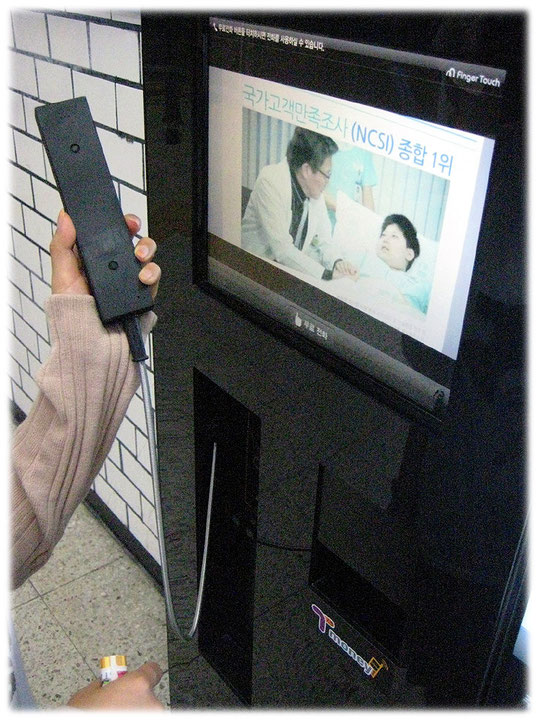
At all Seoul subway stations are public telephones. The good thing is that the first 5 minutes for a local call within South Korea are for free!
In allen U-Bahn-Stationen gibt es mehrere öffentliche Telefone. Das gute daran ist, dass die ersten fünf Minuten für ein lokales Telefonat innerhalb Südkorea kostenlos sind!
This is a picture of a small disinfection device for the H1N1 flu. When the problem of the H1N1 birds flu infection broadened, all subway stations and public buildings in South Korea had been stocked with such devices.
Diese kleine Maschine auf dem Foto dient der Desinfektion der Hände. Als das Problem der H1N1 Vogelgrippe auftauchte, wurden alle U-Bahn-Stationen und öffentlichen Gebäude in Südkorea mit solchen Desinfektionsmaschinen ausgerüstet.

Because of so many people live in Seoul, it is very important to find a system for the daily chaos. Seoul contains 10 million inhabitants, together with the surrounding areas it's almost 20 million! One example to arrange such masses of people is this yellow line you can see in the middle of the escalator on the photo above. Stand left, walk right! Once I saw a group of 20 subway workers standing in a station with a friendly warm smile and encouraging the passing people to do exactly this behavior - to stand left and walk right ^_^
Da sehr viele Menschen in Seoul leben (10 Millionen Koreaner, zusammen mit dem Umland sogar 20 Millionen), muss überall darauf geachtet werden, diese Menschenmassen in geordnete Bahnen zu bringen. So sieht man hier, dass die Rolltreppe eine gelbe Linie aufweist, die dazu ermahnt, rechts zu stehen und links zu gehen. Diese Hinweise finden sich auch an den Treppen und auf der Straße. Einmal habe ich beobachtet wie ca. 20 U-Bahn-Mitarbeiter freundlich in einer Station herumstanden und mit großen Plakaten lächelnd die Passanten genau zu diesem Verhalten aufgerufen haben, nämlich links gehen, rechts stehen ^_^
If a young Korean mother needs to pamper or nurs her baby she can go to the Mom's lounge at the subway station. This rooms also contains a first-aid kit and emergency stuff.
Möchte eine junge koreanische Mutter ihr Baby stillen oder wickeln, so kann sie in der U-Bahn-Station die "Mom's lounge" aufsuchen. Ebenso kann in diesem Raum erste Hilfe geleistet werden, sollte es mal eine Verletzung gegeben haben.
The huge, clean and large-area subway stations can be used for gatherings, speeches and public information presentations.
Die großflächigen und sauberen U-Bahn-Stationen in Seoul werden für Versammlungen, Reden und öffentliche Informationsveranstaltungen genutzt.
The structure of each subway station is exactly explained by dioramas on the station walls (the dioramas look like an old fashioned jump & run video game ^_^). Each station exit has it's own number. Because of the largeness of the stations you should carefully choose the right exit when you leave the station, otherwise you might have no orientation upstairs in the streets. Addresses and directions in Seoul (for example to an administration, to a restaurant or to a shop) always include the exact subway exit number.
Der Aufbau einer U-Bahn-Station wird anhand von Schaubildern genau erklärt (diese sehen lustigerweise wie ein altes Jump & Run-Videospiel aus ^_^). Die Stationsausgänge tragen verschiedene Nummern. Durch die enorme Größe der U-Bahn-Stationen liegen diese Ausgänge oftmals sehr weit auseinander, so dass man unbedingt den richtigen Ausgang erwischen sollte, um nicht die Orientierung zu verlieren. Wegbeschreibungen in Seoul, beispielsweise zu einer Behörde, zu einem Restaurant oder zu einem Geschäft, beinhalten daher auch immer die Nummer des entsprechenden U-Bahn-Ausgangs.
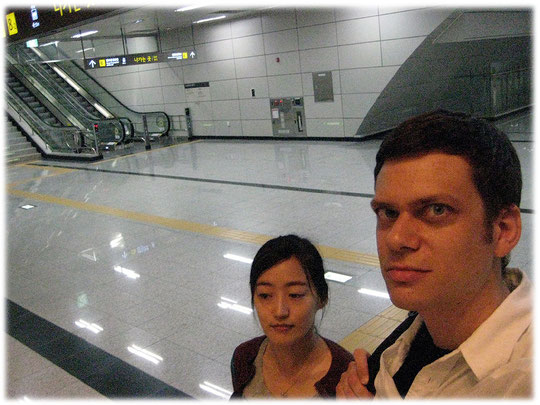
There is one subway line in Seoul which is being used by two trains at the same time, the normal subway train and the express subway train. The normal one stops at each station, the express one stops only at a few stations and is therefore much faster than the normal one. The problem is that both trains share only one track. So the normal subway train has to wait at the stations (only there are two tracks) when the express train wants to overtake. That fact made some people feel angry when the new express subway was established.
Es gibt eine U-Bahn-Linie in Seoul, die von zwei Bahnen gleichzeitig befahren wird, einer normalen U-Bahn, und einer Express-U-Bahn. Die normale U-Bahn hält auf dieser Linie herkömmlich an jeder einzelnen Station. Die Express-U-Bahn aber hält nur an wenigen Stationen und kommt dadurch wesentlich schneller voran. Da beide Züge leider nur ein einziges Gleis zur Verfügung haben, muss die normale U-Bahn immer anhalten, wenn die Express-U-Bahn vorbeifahren möchte. Das hat bei Einführung dieses neuen Systems zu mancher Verärgerung bei den Fahrgästen der normalen U-Bahn geführt.
At many stations you can find an information desk where you can get friendly answers to all your questions concerning the subway journey or the surrounding area of the station.
In vielen Sationen steht ein großer Infoschalter für die U-Bahn-Fahrgäste zur Verfügung, an dem diese kompetent Informationen zu allen ihren Fragen erhalten.
Public restrooms are for free, but sometimes you can't find any toilet paper there. That's why you should have a look at the vending machine at the restroom entrance, which sells the needful paper.
Zwar sind die öffentlichen Toiletten kostenlos, jedoch gibt es dort manchmal kein Klopapier. Dafür steht dann am Eingang ein derartiger Automat bereit, der das Papier verkauft.
Even when you leave the subway station you should keep walking on the right side. Normally the stairs are very crowded, an empty stairway like the one on the photo above is seldom.
Auch beim Verlassen der U-Bahn sollte man sich rechts halten. Für gewöhnlich sind die Treppen völlig überfüllt, nur selten findet sich eine so leere Treppe wie auf dem oberen Bild.
Watch the interesting Seoul subway video:
P i c t u r e s o f S e o u l
Photos and videos about the capital city of South Korea.
Sightseeing tips and inside information for holiday tourists and travelers.
Online tour guide for the everyday life in Korea.
B i l d e r a u s S e o u l
Fotos und Videos aus der Hauptstadt von Südkorea.
Besichtigungs-Tipps und Insider-Informationen für Touristen und Reisende.
Online-Reiseführer durch das Leben in Südkorea.






























